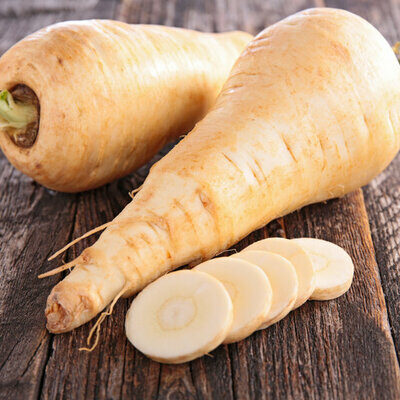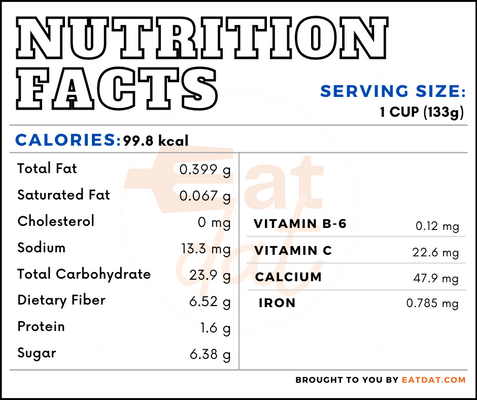
Parsnip
What is Parsnip?
Parsnip is a root vegetable and a member of the Apiaceae family of plants. The word comes from the Middle English word, pasnepe, which translates to fork; however, the ending was changed to nip, because it was originally mistaken for a type of turnip. While it is similar to the turnip and celeriac in taste and texture, it is actually closely related to carrot and parsley.
- Both the flesh and skin are cream in color with a crown of green leaves and stems.
- The vegetable has a taste that is similar to licorice, with spiciness and hints of sweetness.
Some popular ways to use this root vegetable in the kitchen include:
- Baked
- Roasted
- Purées
- Salads
- Soups
- Pies
- Tarts
- Mash
Origin of parsnip
Neolithic parsnip seeds were found by archeologists at the foothills of the Alps in Europe, where the vegetable is believed to have originated and cultivated. It is known that this root vegetable was very popular in ancient European civilizations, including the Celts, Germanics, Slavs, and Romans. This vegetable remained popular throughout Europe, especially in medieval Europe, until the 18th century. After that, potatoes took over as the main root crop.
Nutrition
Nutritional profile for parsnip (1 cup, sliced, 133g):

Parsnip is rich in calcium, magnesium, phosphorous, potassium, vitamin K, and folate. Additionally, it contains sodium, selenium, vitamin C, and vitamin E. Parsnips are classified as a white vegetable and regular consumption may help decrease the risk of diabetes, as well as nervous system, respiratory, gastrointestinal, liver, skin, cardiovascular, and urogenital diseases. This vegetable increases satiety and has a low glycemic index, making it suitable for a healthy snack. Also, it has anti-inflammatory, antispasmodic, vasodilator, antifungal, antimicrobial, and antidepressant properties.
Commercial production
The parsnip is a winter plant and is well able to thrive in frost. In fact, these root vegetables taste better if harvested after a frost. These vegetables grow best in fertile, well-drained soil. They are harvested when the roots began pushing up from the soil. Before storing, the foliage must be removed. They can remain fresh when stored in damp sand or sawdust for up to 6 months.
Parsnip recipes
This vegetable is a hearty and filling root vegetable that is suitable for preparing salads, stews, and soups. Also, it may be cooked and made into a stuffing or filling. Here are a few recipes to try:
- Fiskesuppe
- Nordic Winter Vegetable Soup
- Viltgryte
- Tårta
- Rotmos
- Rotfruktsgratäng
- Parsnip Soup
- Purée de Panais
- Rassolnik
- Zharkoye
- Borscht
- Tušjenyje Harodnina
- Dried Parsnip
- Sałatka Jarzynowa
- Gulasz Wieprzowy
- Gulyas
- Pichelsteiner Topf
FDA regulations
The FDA classifies parsnip under the raw agricultural commodity category. Canned parsnip is defined as the root of the parsnip plant and may be canned whole, quartered, sliced, or diced. The grades and standards for the root are given by the USDA.
References
Wolf D. Storl, Parsnip, Common Vegetables, A Curious History of Vegetables: Aphrodisiacal and Healing Properties, Folk Tales, Garden Tips, and Recipes, Publicism, https://publicism.info/gardening/curious/20.html
Parsnips, The Old Farmer’s Almanac, https://www.almanac.com/plant/parsnips
Weaver, Connie, and Elizabeth T Marr. “White vegetables: a forgotten source of nutrients: Purdue roundtable executive summary.” Advances in nutrition (Bethesda, Md.) vol. 4,3 318S-26S. 1 May. 2013, doi:10.3945/an.112.003566, https://www.ncbi.nlm.nih.gov/pmc/articles/PMC3650503/
Kenari, Hoorieh Mohammadi et al. “Review of Pharmacological Properties and Chemical Constituents of Pastinaca sativa.” Journal of pharmacopuncture vol. 24,1 (2021): 14-23. doi:10.3831/KPI.2021.24.1.14, https://www.ncbi.nlm.nih.gov/pmc/articles/PMC8010426/
